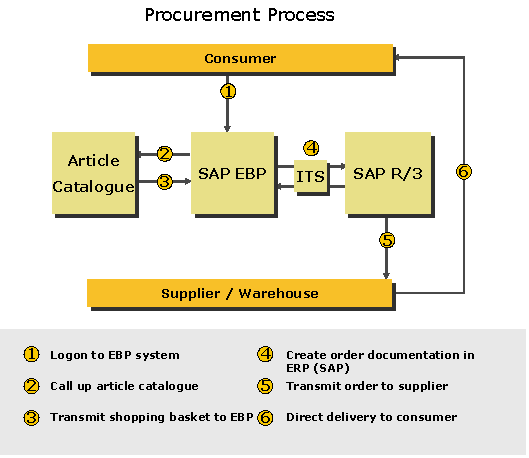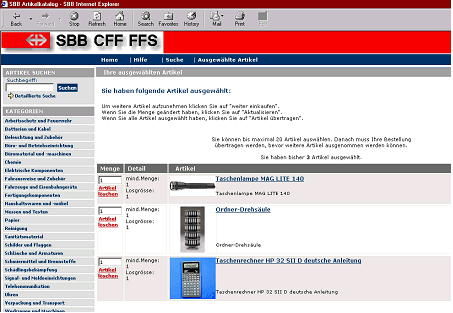E-Procurement at Swiss Federal Railways (SBB)
With around 28,000 employees, Swiss Federal Railways (SBB AG) is Switzerland’s largest transportation company. Since the introduction of the SAP Enterprise Buyer Professional (EBP) electronic procurement solution on 1st July 2001, more than 1,100 end users can now access over 20,000 C articles in an SBB-specific catalogue. Aided by a simple, internet-based catalogue, product information, images and prices for C articles can be called up and the articles ordered. As a consequence of the IT solution and the internal changes that came with it, the cost of procurement processes and process lead times could be significantly reduced.
1. The company
With around 28,000 employees, Swiss Federal Railways (SBB AG) is Switzerland’s largest transportation company. Purchasing is organised centrally and positioned within the Infrastructure department as an independent business unit. 90% of turnover in central purchasing is generated by internal customers, the other 10% is attributable to external business partners such as other rail operators. In 2000, a total procurement volume exceeding CHF 500 million was turned over in this area, CHF 50 million of it purely in the C-article area.
2. Initial situation
Manual procurement activities and the low degree of automation in procurement processes mean that the process costs of an order often exceed the good’s actual value, which in turn creates disproportionately high procurement costs. This area is thus primely suited for an E-Procurement solution.
Swiss Federal Railways (SBB) spent CHF 60 million in 2000 on pencils, pens, light bulbs and other consumables known as C articles. That is a considerable sum. The potential for savings is worth consideration. SBB soon realised that the switch to electronic procurement (E-Procurement) was the right solution.
3. The decision to switch to electronic procurement
E-Procurement solutions automate the procurement process from demand to payment. They promise a faster and measurable return on investment (ROI) because they lead to transparent and accelerated processes and thus to lower transaction times and simplification and standardisation of procedures.
In July 2000, SBB began with the launch of an E-Procurement solution. The goal was to simplify procurement and to achieve clear reductions in purchasing costs in the C-article area. This included, among others, defining a new purchasing strategy, optimising the supplier situation and consistent master-agreement management, an overhaul of SBB’s internal stock management and streamlining the product portfolio. This was to be implemented by launching SAP EBP 2.0c (Enterprise Buyer Professional), connected to the existing SAP R/3 platform. The catalogue software Intershop enfinity 2.1 was also deployed.
For SBB, one condition for the introduction of an E-Procurement solution was a faster and measurable return on investment (ROI). Taking into account the underlying situation specific to SBB and the consistent implementation of the detailed operational concepts, ROI is calculated at one and a half years.
4. Method and approach
Within the scope of an analysis of the current situation, the existing procurement processes, the current supplier and warehouse situation, the product portfolio and the technology used were all investigated in detail. The following solutions for reorganisation were drawn up for the detailed concept below:
Review and redefinition of warehouse processes:
The SBB’s inventory management can be scrutinised for its economic viability using a method developed especially for the rail operator, which incorporates both business data and company-specific criteria. These methods led to a considerable reduction in storage costs.
Development of consistent supplier management:
By introducing a specific set of criteria, all C-article suppliers are incorporated in a transparent valuation system. It allows not only comparison and valuation of prices but also of suppliers, enabling consistent supplier management. In concrete terms, it means that the number of suppliers has been reduced from 1,400 to around 150, with no changes to the product portfolio. A continuously updated database now ensures that supplier quality is constantly monitored and can be compared to market requirements.
Restructuring and segmentation of the product portfolio:
The product portfolio of the entire C-article area has been restructured and reclassified. The basis for this was provided by the international standard classification according to UN/SPSC. This enables suppliers to use a uniform and standardised article design for various customers. So far, 20,000 C articles have been classified and incorporated into the user-friendly online catalogue.
Concentration on strategic tasks:
The introduction of SAP EBP eases the workload of operative tasks for purchasing since it allows 1,100 users to order articles locally using a simple and intuitive internet user interface to an electronic catalogue containing over 20,000 C articles. It enables purchasing to concentrate on strategic focuses. The purchasing department has been transformed from an operative to a strategic one, with focuses in the areas of supplier management, customer service and purchasing market research. Other value-creating activities are now performed by consumers and no longer by purchasing.

Fig. 1: Procurement process
5. Catalogue management
The online catalogue is the visiting card of any E-Procurement system. High-grade article data accompanied by meaningful texts, images and company-specific prices help customers to select the articles they require and ensures cost transparency. SBB decided in favour of a multi-supplier catalogue that is located within SBB network boundaries for data security reasons. Various suppliers’ offers are available online in a multi-supplier catalogue. SBB worked with an external company in developing and maintaining the catalogue content. This ensured the single point of entry for all supplier catalogues in the catalogue management process. It also provides data quality and the generation of the catalogues in XML format necessary for importing into SBB-internal systems. This type of catalogue management guarantees swift incorporation of new supplier catalogues, concentration on the core business in corporate purchasing, standardisation and rationalisation of article data and the use of technical and business standards such as XML and UN/SPSC.
SAP’s Enterprise Buyer Professional (EBP) software forms the core of the implemented E-Procurement solution. It mirrors SBB’s organisational structure and encompasses complex user management with role definitions and corresponding rights. Intershop’s enfinity 2.1 catalogue software is the second important component of the implemented electronic procurement solution. It mirrors the entire article portfolio and enables users to fill their shopping baskets and transfer them to the EBP system. Close integration of the E-Procurement solution with the SAP R/3 ERP system guarantees an end-to-end process – from creation of demand to payment.

Fig. 2: Excerpt from the SBB-specific catalogue for C articles
6. Result
The introduction of an electronic procurement solution with SAP EBP significantly reduces the costs of procurement processes. It eases the workload of operative tasks for the central purchasing department since it allows 1,100 users to order articles locally using a simple and intuitive internet user interface to a electronic catalogue containing over 20,000 C articles. The number of suppliers has been cut from 1,600 to around 150 today. Further article ranges are currently being added to the catalogue as part of the rollout. A direct link to principal suppliers is also planned.
All in all, the electronic procurement solution represents an improvement of service quality and consequently customer satisfaction. By decentralising demand, central purchasing can now concentrate on strategic activities such as master-agreement management and supplier selection.
7. Lessons learned
Many areas have been effected by the changes brought about by the introduction of the E-Procurement solution, from management to sales and from suppliers to end users. The change process must be actively accompanied by professional change management measures. Only an early and open information policy towards all participants and comprehensive, personalised support in the rollout phase can lead to the desired acceptance of the new corporate processes and to the new solution’s targeted benefit. At SBB, particular attention was paid to communication (e.g. newsletters, website and marketing presentations), permanent support for all areas in which processes have changed and continuous user support. Owing to the high number of end users, specially developed, personalised online training on the intranet played an important role.
With the introduction of SAP EBP 2.0c and Intershop enfinity 2.1, Swiss Federal Railways have laid the foundation for the expansion of existing and the introduction of new functions, such as “procurement cards” for optimising payment processes. The E-Procurement solution also represents the basis for strategic development of E-Business activities in the areas of portals, auctions and electronic calls for bids.



